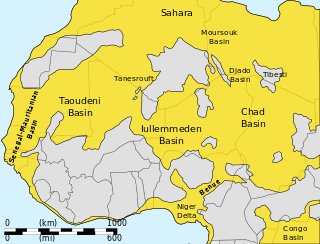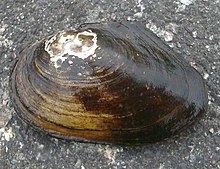Tiourarén Formation
Geological Formation From Wikipedia, the free encyclopedia
Geological Formation From Wikipedia, the free encyclopedia
The Tiourarén Formation is a geological formation in the Agadez Region of Niger whose strata were originally thought to be Early Cretaceous. However, re-interpretation of the sediments showed that they are probably Middle or Late Jurassic (Bathonian-Oxfordian) in age.[1][2] Other works suggested it reaches the Barremian.[3] It is the uppermost unit of the Irhazer Group. Dinosaur remains & other vertebrates are among the fossils that have been recovered from the formation.[4] Originally part of the "Argiles de l'Ihrazer", the Tiouaren Formation primarily comprises reddish to purple siltstones with occasional marls, limestones, and scarce channel sandstones.[1]
| Tiourarén Formation | |
|---|---|
| Stratigraphic range: Middle or Late Jurassic (Suggested post Bathonian, reaching either Oxfordian or even Barremian) | |
 Map showing dinosaur localities around Agadez, Niger | |
| Type | Geological formation |
| Unit of | Irhazer Group |
| Underlies | Tazolé Formation (Tegama Group) |
| Overlies | Irhazer Shale |
| Thickness | ~350 m (1,150 ft) |
| Lithology | |
| Primary | Siltstone, mudstone |
| Other | Sandstone, marl, limestone |
| Location | |
| Coordinates | 16.5°N 7.8°E |
| Approximate paleocoordinates | 8.2°N 2.5°E |
| Region | Agadez |
| Country | |
| Extent | Iullemmeden Basin |
| Type section | |
| Named for | Tiourarén hill, Agadez |
| Named by | Moody R.T.J. & Sutcliffe P.J.C. |

The formation comprises reddish, almost solid mudstones, which also shows grey and white streaks, probably caused by alternating oxidative and reducing environments. Stromatolites are intermittently found in calcareous layers, while indications of semi-arid to arid conditions such as desiccation cracks and caliche horizons have been reported. The formation suggests a low-energy setting with expansive floodplains, temporary shallow lake development,and calcrete horizon interchanged with swamps, with seasonal flooding from a meandering, shallow river system dominated by overbanked silt. Many sandstone channels are composed of reworked sand grain-sized pebbles of mudstone, supporting the view of a predominantly low-relief environment.[2] This latter feature is suggested by the widespread occurrence freshwater ostracod accumulations and rarer unionid bivalve shells.[5]
The Early Cretaceous dating for the Tiouaren Formation was based on vertebrate fossil evidence, specially Mawsoniidae coelacanths (referred without evidence to Mawsonia lavocati), while other taxa like Hybodus? sp. and Lepidotes? sp., are either dubious or have a suggested wide temporal distribution and invertebrates (conchostracans and unionid bivalves), offer limited stratigraphic value.[1] Recent report of an ash bed and other potentially datable beds near fossil bearing horizons opens the possibility of a future age calibration.[6]
Color key
|
Notes Uncertain or tentative taxa are in small text; |
| Fishes | ||||||
|---|---|---|---|---|---|---|
| Genus | Species | Location | Stratigraphic position | Material | Notes | Images |
| Adrarunio[7] | A. deserticus | Teguidda-n-Adrar | Lower Member | Shells | A nakamuranaiadid freshwater bivalve; one of the earliest known trigonioidoids | |
| Afrohyrioides[7] | A. jowikolensis |
|
Upper Member | Shells | A unionid freshwater bivalve | |
| Coactunio[7] | C. iguallalensis |
|
Upper Member | Shells | A unionid freshwater bivalve | |
| Paraheudeana[7] | P. soudanensis |
|
All Members | Shells | A margaritiferid freshwater bivalve | |
| Rostrunio[7] | R. lapparenti | KP-35, Zinder track | Upper Member | Shells | A unionid freshwater bivalve | |
| Saharella[7] | S. tedreftensis | Reg Tamesna | Upper Member | Shells | A unionid freshwater bivalve | |
| Tamesnella[7] | T. amatouensis |
|
Upper Member | Shells | A tamesnelloid freshwater epifaunal substrate bivalve | |
| Tamesnelloides[7] | T. lithoides | SE of In-Afer | Upper Member | Shells | A tamesnelloid freshwater epifaunal substrate bivalve | |
| Tegulaedon[7] | T. humei |
|
Upper Member | Shells | A margaritiferid freshwater bivalve | |
| Tuaregunio[7] | T. agadesensis | KP-35, Zinder track | Upper Member | Shells | A unionid freshwater bivalve | |
| Unionelloides[7] | U. globulosus |
|
Upper Member | Shells | A unionid freshwater bivalve | |
| U. (Phortunio) giganteus | 10 km E of In-Abangarit | |||||
| U. bellalensis | 35 km NE of Mount Bellal | Upper Member | Shells | |||
| Unionida[7] | Indet A | Reg Tamesna | All Members | Shells | Indeterminate A unionid freshwater bivalves |  |
| Indet. B | Teguidda-n-Adrar | |||||
| Fishes | ||||||
|---|---|---|---|---|---|---|
| Genus | Species | Location | Stratigraphic position | Material | Notes | Images |
| Asiatoceratodus[1][8] | A. tiguidensis |
|
Upper Member | Isolated tooth plates & other remains | An asiatoceratodontid lungfish | |
| Ceratodus[9] | C. sp. | Tuiguidit foreland | Upper Member | Tooth plates | A ceratodontid lungfish |  |
| Holostei[9] | Indeterminate | Tuiguidit foreland | Upper Member | "scales of ganoid fishes" | Indeterminate fish remains | |
| Hybodus?[1] | H.? spp. |
|
Upper Member | Teeth | A hybodontiform chondrichthyan |  |
| Mawsoniidae[1][10] | Indeterminate | Upper Member | Teeth, isolated scales & partially articulated remains of the caudal fin | A coelacanth, previously referred to Mawsonia | ||
| Lepidotes?[1] | L. spp. | Upper Member | Isolated scales | A lepisosteiform bony fish | ||
"Turtle Bones" where quoted in the OR description of the unit.[5]
| Turtles | ||||||
|---|---|---|---|---|---|---|
| Genus | Species | Location | Stratigraphic position | Material | Notes | Images |
|
Indeterminate |
Irhazer Plain |
Upper Member |
Isolated egg |
Based on the "small size, spherical shape, and small pores" was suggested it belonged to a turtle |
||
"Crocodiles" where quoted in the OR description of the unit.[5]
| Crocodylomorphs | ||||||
|---|---|---|---|---|---|---|
| Genus | Species | Location | Stratigraphic position | Material | Notes | Images |
| Crocodylomorpha[9] | Indeterminate |
|
Upper Member | Teeth, osteoderms | Indeterminate crocodylomorph remains | |
| Goniopholididae[13] | Gen. et sp. nov A | Irhazer Plain | Upper Member | Complete skull | The first African goniopholidids, suggesting connections with Laurasia | |
| Gen. et sp. nov B | Irhazer Plain | Upper Member | Narrow cranium with elongated snout | |||
"Rare (in abundance) pterosaurs" where quoted in the OR description of the unit.[5]
| Dinosaurs | ||||||
|---|---|---|---|---|---|---|
| Genus | Species | Location | Stratigraphic position | Material | Notes | Images |
| Afrovenator[14][15] | A. abakensis | Abaka, Agadez | Upper Member | UC OBA 1, partial skull and associated postcranial remains | An afrovenatorine megalosauroidean |  |
| A? sp. | NE of Tadibene | Upper Member | TP4-12, rostral part of left maxilla | |||
| Cf. A sp.[16][12] | Tawachi | Upper Member | Premaxillae, dentaries and appendicular skeleton | |||
| Allosauridae[15] | Indeterminate | NE of Tadibene | Upper Member | TP4-6; TP4-7, isolated teeth | Teeth referred to allosaurids or basal allosauroids | |
| Ceratosauria[15] | Indeterminate | NE of Tadibene | Upper Member | TP4-4, isolated teeth | An indeterminate ceratosaur | |
| Eusauropoda[6] | Gen. et sp. nov 1 | Irhazer Plain | Lower Member | Skull and multiple articulated postcranial skeletons | A notoriously complete taxon with stocky proportions, robust skull, and short neck | |
| Gen. et sp. nov 2 | Agadez | Upper Member | Dorsal vertebrae, humerus, and femur | Differs from other local taxa on pleurocoels on posterior dorsal vertebrae and a longer humerus relative to the femur | ||
| Jobaria[17] | J. tiguidensis |
|
Upper Member | Skull and several skeletons | A sauropod, maybe a eusauropod; among the most abundant terrestrial vertebrates in the formation |  |
| Megalosauridae[15] | Indeterminate | NE of Tadibene | Upper Member | TP4-5, TP4-8, TP4-10, teeth | An indeterminate megalosaur | |
|
"R." tamesnensis[14] |
Tamerát, Agadez |
Upper Member |
Dorsal vertebrae and scapula |
An indeterminate sauropod, also reported from younger Cretaceous beds, likely representing different taxa. |
||
| Sauropoda[19][9] | Indeterminate |
|
Upper Member |
|
Indeterminate or unnamed sauropod remains | |
|
Indeterminate |
NE of Tadibene |
Upper Member |
TP4-2, TP4-3 , teeth |
Referred to spinosaurs, may be of ceratosaur origin instead |
||
| Spinostropheus[20] | S. gautieri |
|
Upper Member | Remains of many individuals including cervical, dorsal, and caudal vertebra, partial left humerus, ulna, distal pubis, distal femur, incomplete tibia, fibulae, metatarsals, pedal phalangeal fragments, and manual unguals[21] | Possibly a basal ceratosaurian, a basal abelisauroid, or a noasaurid |  |
| Thyreophora[22] | Gen. et sp. nov |
|
Upper Member | "Associated, but disarticulated, bones, teeth, and abundant scutes from many individuals ranging in maturity from subadult to adult" | A basal thyreophoran, suggested to be related to Scutellosaurus. A relatively common taxon, with a bonebed of up to twenty individuals.[10] | |
| Turiasauria[23] | Gen. et sp. nov | Agadez | Upper Member | Partial articulated skeletons | Differs from Jobaria in deflected humeral head, shorter to the ulna and radius | |
Seamless Wikipedia browsing. On steroids.
Every time you click a link to Wikipedia, Wiktionary or Wikiquote in your browser's search results, it will show the modern Wikiwand interface.
Wikiwand extension is a five stars, simple, with minimum permission required to keep your browsing private, safe and transparent.